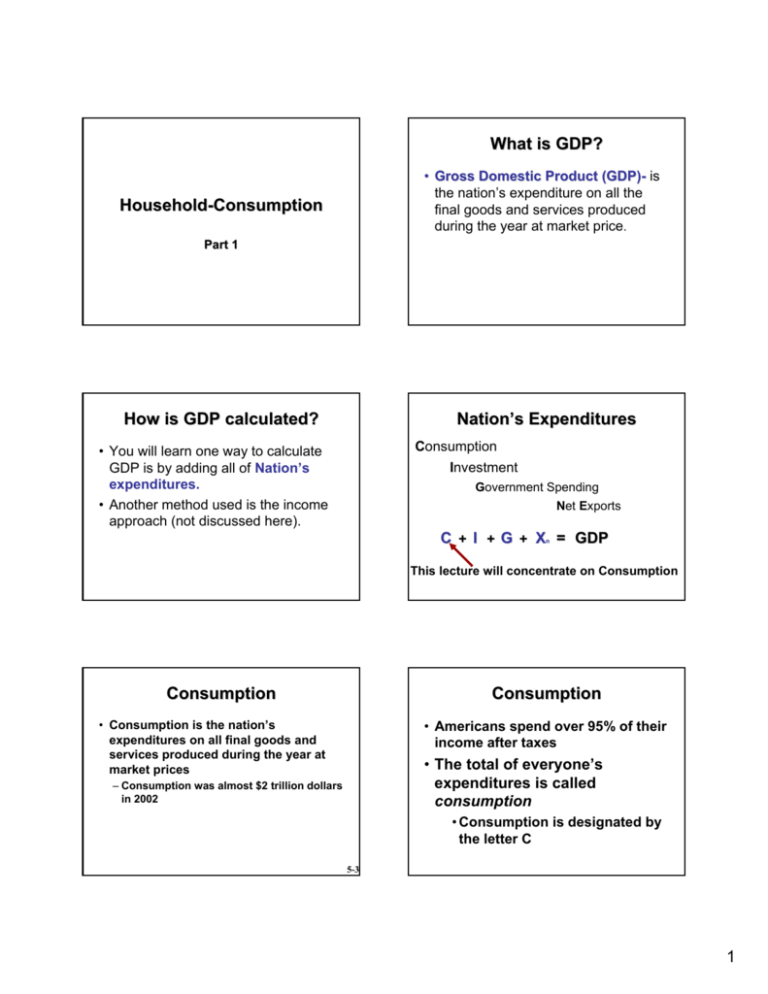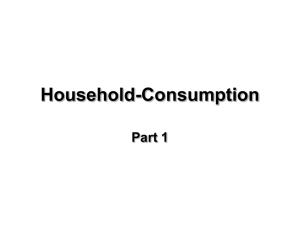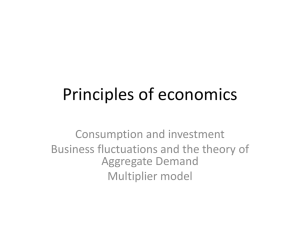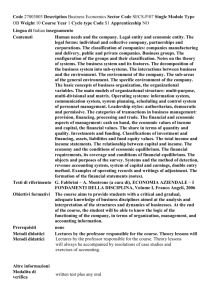
What is GDP?
• Gross Domestic Product (GDP)(GDP)- is
the nation’s expenditure on all the
final goods and services produced
during the year at market price.
Household-Consumption
Part 1
How is GDP calculated?
Nation’s Expenditures
Consumption
Investment
• You will learn one way to calculate
GDP is by adding all of Nation’s
expenditures.
• Another method used is the income
approach (not discussed here).
Government Spending
Net Exports
C + I + G + X = GDP
n
This lecture will concentrate on Consumption
Consumption
Consumption
• Consumption is the nation’s
expenditures on all final goods and
services produced during the year at
market prices
• Americans spend over 95% of their
income after taxes
• The total of everyone’s
expenditures is called
consumption
– Consumption was almost $2 trillion dollars
in 2002
• Consumption is designated by
the letter C
5-3
1
Consumption (Continued)
• C is the largest sector of GDP
• The consumption functions states
–As income rises, consumption
(C) rises, but not as quickly
• C is just over two-thirds of GDP
–Therefore, consumption varies
with disposable income (DI)
Consumption and Disposable
Income
Disposable Income
Consumption
1,000
1,400
2,000
2,200
3,000
3,000
4,000
3,800
5,000
4,600
Consumption and Disposable
Income
As Income rises so does Consumption
BUT NOT AS QUICKLY!
DI increases . . . C increases but by a smaller
amount
DI decreases . . . C decreases but by a smaller
amount
5-7
Consumption and Disposable
Income (Continued)
Disposable Income
Consumption
1,000 + 1000
1,400
+ 800
2,000 + 1000
3,000
2,200
+ 800
4,000
3,800
+ 1000
5,000
+ 1000
3,000
Two Ways To View ConsumptionIncome Relationship
1. As the ratio of total consumption
to total disposable income.
2. As the relationship of changes
in consumption to changes in
disposable income.
+ 800
+ 800
4,600
Copyright ©2002 by The McGraw-Hill Companies, Inc. All rights reserved.
5-8
2
Average Propensity to
Consume (APC/The Percent of
DI Spent)
Average Vs. Marginal
• The average propensity to consume
(APC) is total consumption in a given
period divided by total disposable income.
APC =
Total consumption
C
=
Total disposable income YD
APS =
Total saving
S
=
Total disposable income YD
Consumption
APC = ----------------------------------Disposable Income
5-11
Table 2
Table 2 (Continued)
Disposable Income
Consumption Saving
Disposable Income
Consumption Saving
$40,000
$30,000
$40,000
$30,000
$10,000
C
30000
3
DI
40000
4
APC = ------------ = ------------ = ------ = .75
5-12
Copyright ©2002 by The McGraw-Hill Companies, Inc. All rights reserved.
5-13
Table 2 (Continued)
Table 2 (Continued)
Disposable Income
Consumption Saving
Disposable Income
Consumption Saving
$40,000
$30,000
$40,000
$30,000
$10,000
C
30000
3
DI
40000
4
APC = ------------ = ------------ = ------ = .75
$10,000
C
30000
3
DI
40000
4
APC = ------------ = ------------ = ------ = .75
+
S
10000
1
APS = -----------= -----------= -----= .25
DI
40000
S
10000
1 = .25
APS = -----------= -----------= ------
4
DI
5-14
40000
4
1.00
5-15
3
Table 3
Table 3 (Continued)
Disposable Income
Saving
Disposable Income
Saving
Consumption
$20,000
$1,500
$20,000
$1,500
$18,500
5-16
5-17
Table 3 (Continued)
Table 3 (Continued)
Disposable Income
Saving
Consumption
Disposable Income
Saving
Consumption
$20,000
$1,500
$18,500
$20,000
$1,500
$18,500
C
18500
37
C
18500
37
DI
20000
40
DI
20000
40
APC = ------------ = ------------ = ------ = .925
APC = ------------ = ------------ = ------ = .925
S
1500
3 = .075
APS = -----------= -----------= -----DI
20000
40
5-18
Table 3 (Continued)
Disposable Income
$20,000
Saving
$1,500
APCs Greater than One
Consumption
$18,500
C
18500
37
DI
20000
40
5-19
Disposable Income
Consumption
$10,000
$12,000
Saving
APC = ------------ = ------------ = ------ = .925
+
S
1500
3 = .075
APS = -----------= -----------= -----DI
20000
40
1.00
5-20
4
APCs Greater than One
APCs Greater than One
(Continued)
Disposable Income
Consumption
Saving
Disposable Income
Consumption
Saving
$10,000
$12,000
- 2000
$10,000
$12,000
- 2000
C
$12,000
12
DI
$10,000
10
APC = ------------ = ------------ = ------ = 1.2
Where is this going to come from?
5-23
APCs Greater than One
APCs Greater than One
Disposable Income
Consumption
Saving
Disposable Income
Consumption
Saving
$10,000
$12,000
- 2000
$10,000
$12,000
- 2000
C
$12,000
12
DI
$10,000
10
APC = ------------ = ------------ = ------ = 1.2
C
$12,000
12
DI
$10,000
10
APC = ------------ = ------------ = ------ = 1.2
+
S
-$2,000
-2
S
APS = ------------ = ------------ = ------ = -0.2
DI
$10,000
DI
5-24
APC + APS = 1
-$2,000
-2
APS = ------------ = ------------ = ------ = -0.2
10
$10,000
10
1.00
Copyright ©2002 by The McGraw-Hill Companies, Inc. All rights reserved.
5-25
The Marginal Propensity to
Consume
• The marginal propensity to consume
(MPC) is the fraction of each additional
(marginal) dollar of disposable income
spent on consumption.
APS = 0.20
APC = 0.80
5
Marginal Propensity
to Consume (MPC)
Marginal Propensity
to Consume (MPC)
Table 4
MPC =
CHANGE
in Consumption
CHANGE
in Income
Year
DI
C
1998
$30000
$23000
1999
$40000
$31000
S
$7000
$9000
5-27
Copyright ©2002 by The McGraw-Hill Companies, Inc. All rights reserved.
Marginal Propensity
to Consume (MPC)
Table 4 (Continued)
Table 4 (continued)
Year
DI
C
1998
$30000
$23000
$7000
10000
8000
2000
1999
$40000
$31000
$9000
Table 4 (Continued)
DI
1998
$30000
$23000
$7000
10000
8000
2000
1999
$40000
$23000
$7000
Change
10000
8000
2000
$40000
C
S
$31000
$9000
Change in C
8000
8
Change in DI
10000
10
Copyright ©2002 by The McGraw-Hill Companies, Inc. All rights reserved.
5-29
The MPC and MPS
Year
Change
C
$30000
MPC =---------------- = ---------- = ------- = .8
5-28
Copyright ©2002 by The McGraw-Hill Companies, Inc. All rights reserved.
DI
1998
1999
S
Change
Year
S
$31000
$9000
Change in C
8000
8
Change in DI
10000
10
MPC =---------------- = ---------- = ------- = .8
+
Change in S
2000
2
Change in DI
10000
10
MPS = -------------- = ---------- = -------- = .2
MPS = 0.20
1.0
MPC = 0.80
5-30
6





